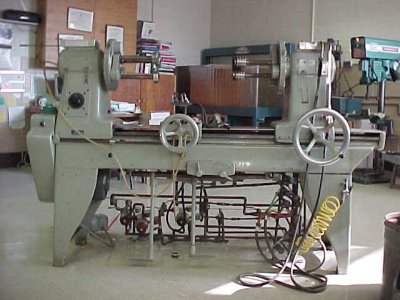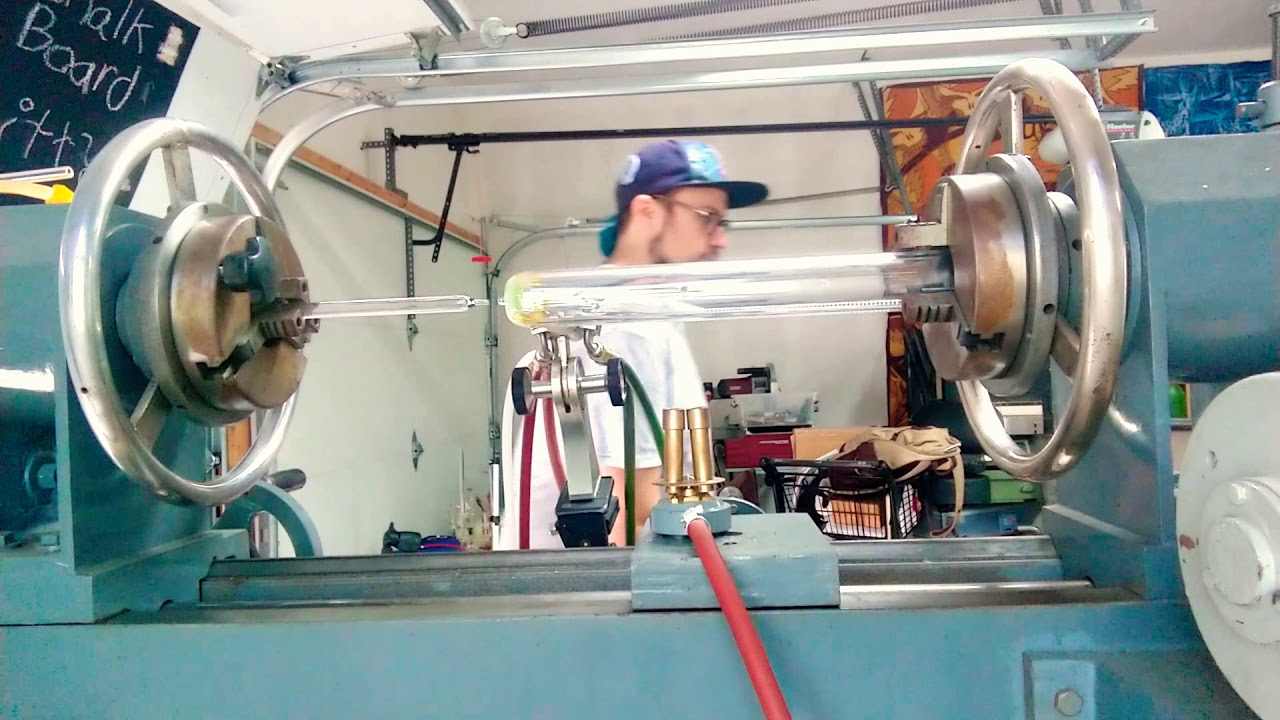Ever wondered if you can lathe glass? Well, you’ve come to the right place! Let’s dive into the fascinating world of glass lathe work.
Before we get started, you might be wondering, “What exactly is glass lathe?” Simply put, it’s a process that involves shaping and polishing glass using a lathe machine.
Now, you might be thinking, “Why would anyone want to lathe glass?” Well, the answer is simple – glass lathe allows for incredible precision and control, enabling artisans to create beautiful and intricate glassware.
So, if you’re ready to uncover the secrets of glass lathe, keep reading to discover the possibilities and unleash your creative spirit!
1. Begin by choosing a suitable glass blank.
2. Secure the glass blank onto the lathe chuck.
3. Use a diamond-tipped lathe tool to remove excess material.
4. Carefully shape the glass by turning it with the lathe.
5. Use sandpaper, water, and polishing compounds to smooth the glass.
With patience and practice, you can create beautiful glass pieces on a lathe!

Can You Lathe Glass? Exploring the Possibilities and Techniques
When it comes to working with glass, one might assume that it is too delicate and brittle to be shaped using traditional woodworking tools. However, with the right techniques and precautions, it is indeed possible to lathe glass and create beautiful and intricate designs. In this article, we will delve into the process of glass lathing, exploring the necessary tools, the techniques involved, and the potential applications for this unique craft. Whether you are a seasoned woodworker looking to venture into new artistic territories or simply curious about the possibilities, join us as we uncover the world of glass lathing.
Tools and Safety Precautions for Glass Lathing
Before diving into the techniques of glass lathing, it is crucial to understand the tools required and the safety precautions that need to be taken. Here, we will discuss the essential equipment as well as the measures you should undertake to ensure a safe and successful glass lathing experience.
1. Tools for Glass Lathing
When it comes to glass lathing, a few specialized tools are required to achieve the desired results. The most important tool in this craft is the glass lathe itself. This lathe is specifically designed for working with glass and has a sturdy, stable base that can withstand the weight and vibrations incurred during the process. In addition to the lathe, other essential tools include a diamond-tipped cutting tool, a coolant system, and a polishing wheel. These tools work together to shape the glass and bring out its brilliance.
In terms of safety gear, protective eyewear and gloves are a must when working with glass. Glass shards can be sharp and potentially hazardous, so ensuring your safety should always be a priority. Investing in high-quality safety equipment is essential to prevent accidents and injuries.
2. Safety Precautions
When working with glass, it is important to take certain safety precautions to minimize the risk of accidents. Here are some key measures to consider:
- Always wear safety glasses or goggles to protect your eyes from glass shards.
- Wear gloves to protect your hands from cuts and avoid direct contact with the glass.
- Work in a well-ventilated area to prevent inhaling glass dust or fumes, especially when using a coolant system.
- Ensure that the work area is clean and free from clutter to avoid tripping hazards.
- Keep a first aid kit nearby in case of any accidents or injuries.
Getting Started with Glass Lathing: Techniques and Tips
Now that we have covered the necessary tools and safety precautions, let’s dive into the techniques and tips for glass lathing. While glass lathing requires a certain level of skill and precision, with practice and patience, you can achieve stunning results. Here are some essential techniques and tips to get you started on your glass lathing journey.
1. Selecting the Right Glass
Before beginning a glass lathing project, it is important to choose the right type of glass. Not all glass is suitable for lathing, as some may be too fragile or prone to cracking. Opt for borosilicate glass or fused quartz glass, as these materials are more durable and resistant to thermal shock. It is also advisable to start with smaller and simpler projects to build your confidence and skill before moving on to more complex designs.
2. Planning and Sketching
Before you start shaping the glass on the lathe, it is beneficial to have a clear plan and sketch of your design. This will help you visualize the final product and guide your shaping process. Take measurements, note down the proportions, and plan the different stages of shaping before you begin. This will ensure a more streamlined and efficient workflow.
3. Taking it Slow
Glass lathing is a delicate process that requires patience and attention to detail. Take your time when shaping the glass, and avoid rushing or applying too much pressure. Begin with light passes and gradually increase the depth of the cuts as you get more comfortable. Remember, the key is to let the glass dictate the pace and follow its lead. With practice, you will develop a better understanding of the material and the optimal shaping techniques.
4. Cooling and Polishing
Throughout the glass lathing process, it is crucial to keep the glass cool to prevent it from cracking or shattering due to thermal stress. Use a coolant system or constantly dip the glass into cool water to maintain a stable temperature. Once the shaping is complete, it’s time to move on to the polishing stage. Use a polishing wheel and a fine abrasive compound to bring out the glass’s natural luster and remove any scratches or imperfections.
Applications of Glass Lathing
Glass lathing opens up a world of creative possibilities and can be used to create a variety of stunning objects and artworks. Here are some common applications of glass lathing:
1. Glass Sculptures and Art Installations
Glass lathing allows artists and sculptors to create intricate and unique glass sculptures. The ability to shape the glass into precise forms opens up endless possibilities for creating visually striking art installations.
2. Glass Jewelry
Glass lathing can also be used to create one-of-a-kind jewelry pieces. Imagine wearing a pendant or earrings made from glass that has been skillfully lathed to perfection, showcasing its natural beauty and brilliance.
3. Glassware and Decorative Objects
Glass lathing can be employed to create exquisite glassware such as vases, bowls, and decorative objects. The process allows for intricate detailing and precise shaping, resulting in functional yet artful pieces.
The Fascinating World of Glass Lathing
Glass lathing is a captivating craft that combines artistry and precision. With the right tools, techniques, and safety precautions, you can explore the possibilities of shaping glass and create extraordinary works of art. Whether you are a seasoned artist or a beginner looking for a new creative outlet, glass lathing offers a unique and rewarding experience. So, gather your tools, put on your safety gear, and embark on a journey into the fascinating world of glass lathing.
Key Takeaways: Can You Lathe Glass?
1. Glass can be lathed, but it requires special tools and techniques.
2. Lathing glass involves spinning it against a cutting tool to shape and smooth it.
3. The process requires high precision and skill to avoid breaking the glass.
4. Lathing glass is commonly used in the production of scientific glassware and decorative items.
5. It is recommended to seek professional assistance or training before attempting to lathe glass at home.
Frequently Asked Questions
Introduction:
Looking to learn about glass lathing? Here are some commonly asked questions and answers to help you understand the process.
1. Is it possible to lathe glass?
Absolutely! Glass lathing, also known as glass turning or glass spinning, is a technique used to shape glass using a lathe machine. While lathing is commonly associated with wood or metal, it can also be used on glass. By rotating the glass on the lathe, it allows for precise cuts, grinding, and shaping. Glass lathing can create intricate designs and smooth finishes on various types of glass objects.
When lathing glass, it’s important to use tools specifically designed for working with glass. Diamond-embedded wheels or discs are commonly used to cut and shape the glass. Safety measures, such as wearing protective goggles and gloves, should always be followed to avoid injury. With proper technique and experience, glass lathing can yield beautiful and unique glass creations.
2. What are some applications of glass lathing?
Glass lathing has a wide range of applications. It is commonly used in the production of scientific glassware, such as laboratory equipment and glass tubes. By lathing glass, intricate shapes and precise dimensions can be achieved, making it ideal for creating specialized scientific apparatus.
Furthermore, artists and glassblowers utilize glass lathing to create decorative glass objects. It allows them to shape and refine their designs, bringing their artistic visions to life. From intricate glass sculptures to delicate glass ornaments, lathing gives artists the ability to work with precision and create stunning pieces.
3. Can anyone lathe glass, or does it require specialized skills?
While glass lathing can be learned, it does require specialized skills and experience. The process of working with glass on a lathe requires knowledge of glass properties, cutting techniques, and tool handling. It is crucial to understand the capabilities and limitations of the glass material being used.
Learning glass lathing typically involves hands-on training and practice. Beginners are advised to start with simpler projects before moving on to more complex designs. Attending workshops or classes taught by experienced glass turners can be a great way to gain the necessary skills and knowledge.
4. What types of glass are suitable for lathing?
Various types of glass can be lathed, but the suitability depends on the specific project and desired outcome. Borosilicate glass, also known as “hard glass,” is a popular choice due to its durability and resistance to thermal shock. It is commonly used in scientific glassware and can be shaped and lathed with precision.
Other types of glass, such as soda-lime glass or fused quartz, can also be lathed but may require different techniques and considerations. It is important to understand the properties of the glass being used and consult with experienced glass turners or professionals to determine the best approach for lathing a specific type of glass.
5. Are there any safety precautions to take when lathing glass?
Yes, there are important safety precautions to take when lathing glass. Since glass lathing involves working with rotating machinery and sharp tools, it is essential to wear protective gear. Safety goggles and gloves are a must to protect the eyes and hands from potential injuries caused by glass shards or tool accidents.
It is also important to have a well-ventilated workspace when lathing glass, as some glass materials may release harmful fumes when heated or cut. Additionally, always follow proper handling techniques and use tools specifically designed for lathing glass. Proper training and experience in glass lathing techniques can greatly minimize risks and ensure a safe and enjoyable glassworking experience.

CNC Lathe Machine Working project a glass
Summary
You can lathe glass, but it requires a special type of lathe called a glass lathe. A glass lathe has a diamond cutting tool that can shape the glass. However, it is a complex and delicate process that requires skill and experience. So, if you’re interested in lathe glass, be patient and practice!
